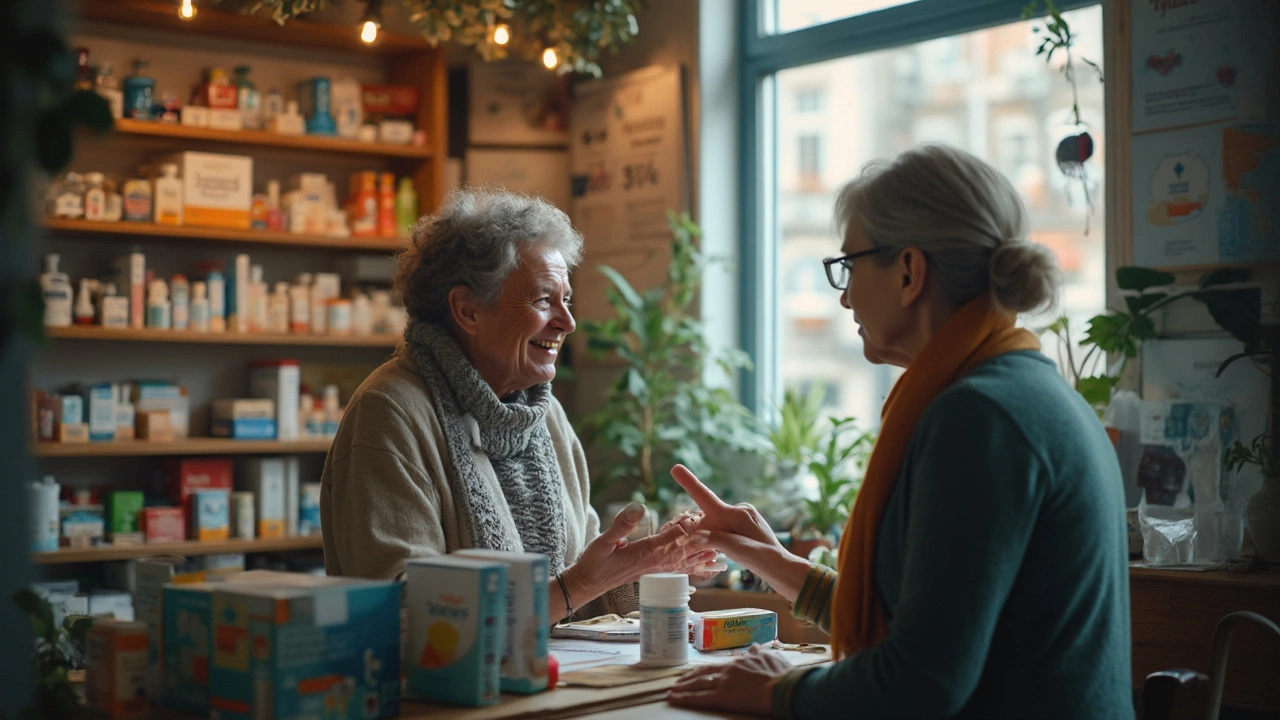If you’ve ever trudged to the chemist, feverish and desperate for relief, you’ve probably heard about Tamiflu. It’s often pitched as the magic flu medicine, the pill that’ll get you back on your feet and out of bed. But is it really that miraculous, or is it just smart marketing packed into a capsule? There’s a wild amount of confusion around Tamiflu—what it actually does, how well it works, and when it’s worth the trouble. Some swear by it, others think it’s a placebo with a fancy label. The reality sits squarely between these extremes, with a heavy dose of ‘it depends’ layered into every decision to pop one of these pills. So, let’s sort out the hype from the facts and figure out who Tamiflu really helps, who might be better off skipping it, and what you should absolutely know before reaching for your wallet and your water glass.
What Exactly Is Tamiflu and How Does It Work?
Time to clear the air around what this stuff actually is. Tamiflu’s proper name is oseltamivir, and it’s an antiviral med, not an antibiotic. That means it targets viruses—in this case, specifically the influenza A and B viruses—and not bacteria. Why does that matter? Because antibiotics won’t do squat for the flu, but Tamiflu is designed to stop the flu virus from multiplying in your body. It’s like setting up a roadblock so the virus can’t make more copies of itself and spread.
The catch with Tamiflu is timing. The drug doesn’t wipe out the flu when you’re already buried by symptoms. Studies show it works best if you start it within 48 hours of your first sneeze, fever, or cough. Wait longer than that, and the benefits start to drop off pretty quickly. Kids and people with certain medical risks might still get some help if it’s started a bit later, but the clock’s definitely ticking.
Many folks are surprised to hear Tamiflu doesn’t ‘cure’ the flu. Instead, it shaves off about a day from the total run time of symptoms if you take it early. According to a respected meta-analysis from The Lancet, average flu duration is about 5-7 days, and Tamiflu can cut that by roughly 24 hours for healthy adults. Not earth-shattering, but if you’re facing work deadlines, kid wrangling, or travel, that day can matter a lot. And for elderly people, infants, pregnant women, or anyone with breathing or heart issues, Tamiflu’s benefits go beyond comfort—it can reduce the chances of complications like pneumonia.
It mostly comes as a capsule or sometimes a liquid for kids and people who struggle with pills. You take it twice a day for five days. Interestingly, Tamiflu can also be used to try to prevent the flu if you've been close to someone who’s sick—what doctors call ‘post-exposure prophylaxis.’ It’s not a guarantee, but if you start the medication quickly after exposure, your odds of staying healthy are higher.
Here’s a quick breakdown:
| When to Start Tamiflu | Effectiveness | Most Common Users |
|---|---|---|
| Within 48 hours | Reduces symptoms by about 1 day; significant reduction in severe complications for high-risk people | Young children, elderly, pregnant women, immune-compromised adults |
| After 48 hours | Much less effective; may help in severe cases or for those at high risk | People hospitalized with the flu, late presenters with serious underlying health issues |
Biggest thing to remember? Tamiflu isn’t a get-out-of-jail-free card. Vaccination is still your best defense, but Tamiflu steps in when flu sneaks past your body’s first barrier.

Myths, Side Effects, and Annoyances: The Real Story
Now let’s talk about what people really experience with Tamiflu—and what you might not hear from a quick doctor’s appointment. First up are the side effects, which don’t always get as much airtime as they probably should. Stomach upset is at the very top of the list. You’ve got nausea, some vomiting, and a good chunk of people complain about weird tummy pain. It’s not unusual—official numbers say around one in ten adults who take the drug deal with this. Headaches show up for some, and occasionally people notice dizziness or trouble sleeping. In rare cases (mostly in kids and teens), there have been reports of confusion or hallucinations, but that happens so rarely you're more likely to win a meat tray at your local RSL.
If you want practical advice, pop Tamiflu with food. It won’t completely prevent nausea, but it does help most people feel a bit less queasy. Hydrate often, and don’t be shy to call your doc if you feel off in ways that don’t fit the usual flu hangover.
Let’s bust a couple of myths while we’re at it. No, Tamiflu won’t help with the common cold or COVID-19 since it’s targeted only at flu viruses. You’re better off saving your cash and resting with Panadol and soup for those. And taking Tamiflu doesn’t mean you’re suddenly non-infectious. You can still pass on the flu, so you shouldn’t skip the tissues or the isolation.
Some people expect Tamiflu to work miracles. Here’s the reality: if you’re generally healthy, you might notice a bit of relief a touch sooner, but you’re still going to deal with tiredness, sore throat, and coughing just like everyone else. People in higher-risk groups (chronic conditions, older adults, young kids) are the ones who’ll get the most life-changing boosts from Tamiflu, which is why doctors push for it in those circles. In my years in Perth, the biggest flu waves have always hit aged care and childcare hardest, so GPs down here are quick to reach for Tamiflu for those groups—but not always for everyone else.
A common question—should you use Tamiflu as a ‘just in case’ prevention tool? If flu is going nuts in your home or office, and you’re close to someone with a confirmed case, Tamiflu can help prevent you getting sick, but you have to start it within two days of your exposure. For most people, though, the cost, hassle, and possible side effects make it more of a backup than a go-to move. Immunization and proper handwashing are much simpler first steps.
You might be surprised to hear that Tamiflu resistance is a thing, just like with some antibiotics. The flu virus can mutate, making the drug a bit less effective during some seasons. So, if your pharmacist tells you Tamiflu isn’t doing much for the local flu, it’s not sales talk—sometimes the strains have shifted enough that Tamiflu’s impact drops.
- Take Tamiflu as early as possible (ideally within 48 hours).
- Eat something with your dose to cut down on nausea.
- Don’t use for prevention unless you’re at high risk or directly exposed.
- Remember: it’s not for colds or COVID-19!
- Watch for rare but weird side effects—especially in kids.

When You Should (and Shouldn’t) Use Tamiflu: Real-World Decisions
So, who really needs this flu medicine, and who can mostly ride it out with rest and Netflix? The answer comes down to your health, age, and timing.
If you’re under five or over 65, pregnant, or living with chronic conditions like asthma, diabetes, or heart disease—doctors recommend Tamiflu right away if the flu comes knocking. These groups are way more likely to get into trouble with flu, landing in hospital or developing complications. Here, that one day’s help in recovery, plus the reduced risk of nasty outcomes, is worth every cent.
For the rest of us—pretty healthy, not immunocompromised, and able to take sick days—Tamiflu’s edge is slimmer. The medicine knocks one day off your fever and aches if you start it early, but after that, it’s all about toughing out the basics: sleep, fluids, and a steady lineup of light meals. Plenty of GPs in Perth (and across Australia) reserve Tamiflu for when family members in a household are at high risk, or when someone’s job (healthcare, aged care) makes fast recovery crucial.
Cost sometimes throws people. In Australia, Tamiflu isn’t cheap for everyone—unless you’re in a risk group or have a health card, the standard course runs about $50 to $60. Some private health funds might chip in, but it’s worth checking first before swiping your card. If you get the flu at odd hours or during a big wave, you may see shortages, too. Not every chemist stocks plenty of supply, and panic-buying sometimes clears shelves when the news talks up a scary flu season.
For parents, Tamiflu comes in liquid form for kids who can’t handle pills. Be careful with dosing—liquid Tamiflu has a slightly odd taste, so mix it with juice or icy treats if you have a fussy patient. And regardless of age, if someone’s symptoms aren’t improving after a few days, or they’re getting worse (high fevers, trouble breathing, confusion), get a doctor involved ASAP. Sometimes it’s not the flu, and it pays to get real medical advice.
There’s a growing debate about Tamiflu and the risk of mental side effects in young people. While the official word—as of June 2025—remains that these effects are rare, it’s smart to keep an eye out if your child or teen takes it. If something feels off, ring your GP. No flu medicine should ever make things scarier than the actual virus.
Last thing—don’t expect Tamiflu to be a magic shield around other people. If you start feeling better, it’s still smart to keep away from your workplace or school for at least 24 hours after your fever breaks (without using fever meds). You may feel alright, but you’re probably still contagious. Think of others, especially if they’re vulnerable.
Savage flu seasons do happen—Perth’s had its share, and some years hospitals fill up with patients fighting complications. Tamiflu plays a role in keeping that burden manageable, mainly for the folks with weaker immune systems or those living in close quarters. But for most healthy adults, the shortcuts to getting better are the same: drink, rest, wait it out, and save those precious sick days for a proper Netflix binge. Tamiflu is a tool, not a panacea, and knowing when to use it makes all the difference.











6 Comments
Tamiflu’s just a Band-Aid on a bullet wound, honestly. It doesn’t cure anything-it just buys you a day so you can maybe get back to scrolling TikTok a little sooner. Kinda like paying extra for ‘fast lane’ at the DMV. The real win is the vaccine. If you’re not getting vaccinated, you’re playing Russian roulette with your immune system. And don’t even get me started on the nausea. I took it once, threw up twice, and still had the flu for a week. Worth it? Nah. But hey, if you’re a parent with a screaming toddler and a deadline, I guess that day matters. Just don’t expect miracles.
Also, why do we treat flu like it’s a war we can win with pills? It’s a virus. We’re not superheroes. Rest. Hydrate. Cry into your soup. That’s the real medicine.
The data on Tamiflu is surprisingly nuanced. Meta-analyses from The Lancet and Cochrane show a modest reduction in symptom duration-about 16 to 17 hours-for otherwise healthy adults. The real clinical value lies in reducing secondary complications, particularly in high-risk populations. For individuals with COPD, congestive heart failure, or diabetes, the reduction in hospitalization risk is statistically significant. However, the number needed to treat (NNT) to prevent one hospitalization is approximately 100, meaning most healthy individuals will experience no tangible benefit beyond marginal symptom relief. Side effect profiles (nausea, vomiting) occur in ~10% of users, which may outweigh benefit for low-risk patients. Cost-benefit analysis must be individualized. Vaccination remains the primary preventive strategy, and antiviral use should be reserved for those with clear clinical risk factors or early exposure in high-density environments.
Thank you so much for this thoughtful, well-researched guide!! 🙏 I’ve been a nurse for 18 years and I can’t tell you how many times I’ve seen families panic-buy Tamiflu like it’s gold, only to be disappointed when it doesn’t ‘cure’ their child. You’re absolutely right-timing is everything. I always tell parents: if your 2-year-old is running a fever and you can get to the clinic within 36 hours, go for it. But if it’s day 3 and they’re just coughing? Let them rest. Hydrate. Use a humidifier. And please, please don’t give them adult doses. I’ve seen so many accidents with the liquid form. 💙 Also, I just wanted to say-I’m so glad you mentioned the mental side effects in teens. That’s so under-discussed. My nephew had a scary episode after taking it. We called his doctor immediately. He’s fine now, but it was terrifying. Thank you for being honest. 💕
Stop pushing this socialist drug. Americans don’t need Tamiflu. We need to toughen up. If you can’t handle the flu without a pill, you’re weak. Vaccines are government propaganda. Rest. Drink broth. Pray. That’s what my grandpa did in 1952 and he lived to 98. Tamiflu is just Big Pharma’s way of stealing your money. And don’t get me started on the ‘high-risk’ nonsense. Everyone’s ‘high-risk’ now. Grow a spine. Stop coddling kids. No one needs a liquid version. Just swallow the pill like a man. And for God’s sake, stop using it as ‘prophylaxis.’ That’s not prevention-that’s weakness.
Bro, Tamiflu is just a neuraminidase inhibitor. It blocks viral release, period. But here’s the kicker-the virus has a fucking mutation rate of 10^-3 per base per replication cycle. So yeah, resistance is real. I’ve seen flu strains in the Midwest where oseltamivir’s IC50 is up 300%. That’s not marketing. That’s evolution. And let’s be real: if you’re not getting tested for influenza A/B before you pop it, you’re just wasting $60 and giving your gut a bad day. Most ‘flu’ cases are rhinovirus anyway. Stop being a lab rat. Just take zinc and sleep. Your immune system is not broken. You just need to stop bingeing Netflix while sick.
Y’all are overthinking this. I took Tamiflu last year when my kid got it. We started it at 38 hours. Didn’t feel like a miracle, but I didn’t puke once (ate it with peanut butter, genius move). My fever broke a day earlier. That’s it. No hallucinations. No drama. Just… less misery. And honestly? If I can be functional enough to work from home and not infect my coworkers? Worth it. 🤷♀️ Also, my grandma’s in a nursing home-she got it after exposure and didn’t get sick. So maybe it’s not magic, but it’s not nonsense either. Just… use it wisely. And wash your hands. Like, actually wash them. 💪🧼